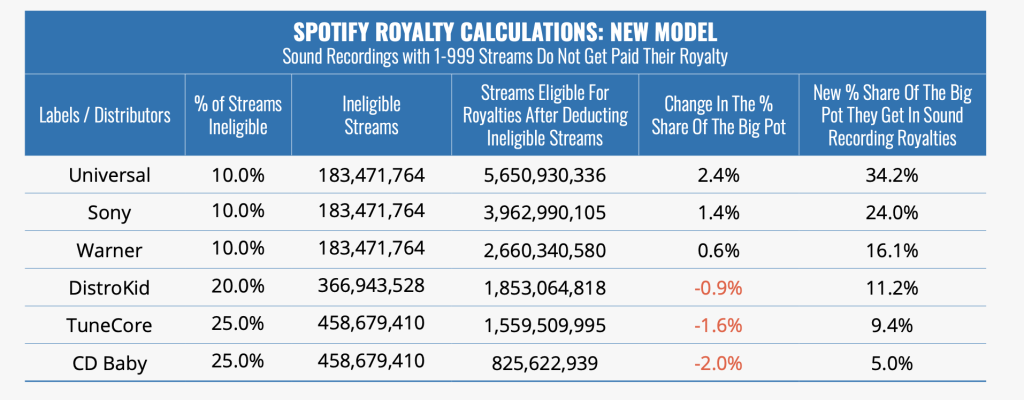Projection of royalty collection changes for major industry players following Spotify’s 1,000-stream minimum payment transition (Image: Digital Music News)
In our latest DMN Pro Weekly Report, guest author Jeff Price offers an exhaustive breakdown of Spotify’s updated payout structure for sound recording royalties — and what if means for everyone in the music industry food chain.
The most remarkable takeaway from this report? For Spotify, the percentage of total revenue allocated to sound recording royalties doesn’t decrease when its new model rolls out in 2024’s Q1. So Spotify’s bottom line won’t benefit from the revamp.
But rising, developing, and indie artists will no longer receive royalties from their sound recordings that stream less than 1,000 times in 12 months. We follow the money to see where those royalties are headed — who stands to benefit monumentally from this updated model?
Report Table of Contents
1. Model Update: Spotify’s Sound Recording Royalty Change
Spotify has provided what appear to be non-related reasons to justify its proposed model that will not pay sound recording royalties to sound recordings with less than 1,000 streams in the prior 12 months.
2. What About The Law: Can Spotify Make This Change?
Does the law allow Spotify to make this leap? Licensing agreements, contractual provisions, term changes, and Spotify’s take-it-or-leave-it offering.
3. Winners And Losers: Major Labels, Higher-Streaming Artists, Spotify
Spotify isn’t changing the total amount of sound recording royalties it pays. What changes is who gets the money.
4. Example #1: Calculating Spotify’s Current Sound Recording Royalties
We explore payouts under Spotify’s current model, where all sound recordings with a 30-second stream earn a royalty.
5. Example #2: Calculating Spotify’s Sound Recording Royalties Payout In 2024
We explore payouts under Spotify’s soon-to-rollout in 2024 model, where sound recordings have to meet an annual minimum threshold of 1,000 streams in the prior 12 months to get paid a sound recording royalty.
6. Example #3: Sound Recording Royalties Based On Actual Spotify Data
-
-
-
- Example 3A: Backed by actual reported data on Spotify streams and revenue reported by The Mechanical Licensing Collective (The MLC), we make market share and streaming number assumptions for six distributors/labels to calculate how sound recording royalties work under Spotify’s current model.
- Table #1: Current Spotify Model — % share of all streams eligible for royalties
- Table#2: Current Spotify Model — $ share of the big pot of royalties
- Example 3A: Backed by actual reported data on Spotify streams and revenue reported by The Mechanical Licensing Collective (The MLC), we make market share and streaming number assumptions for six distributors/labels to calculate how sound recording royalties work under Spotify’s current model.
-
-
-
-
-
- Example 3B: Backed by actual reported data on Spotify streams and revenue reported by The Mechanical Licensing Collective (The MLC), we make market share and streaming number assumptions for six distributors and labels to calculate how sound recording royalties will work under Spotify’s new 2024 model.
-
-
-
-
- Table #3: 2024 Model — Change in % share of the big pot of royalties
- Table #4: 2024 Model — Change in $ share of the big pot of royalties
-
7. The New Boss: Same as the Old Boss?
Rather than focus on innovation, working to find more artists that would thrive in their system, or creating a lucrative business to support these developing artists (think DistroKid, TuneCore etc.), the majors instead come up with new schemes to take other artists’ money.

